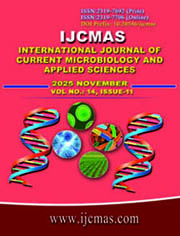


 National Academy of Agricultural Sciences (NAAS)
National Academy of Agricultural Sciences (NAAS)

|
PRINT ISSN : 2319-7692
Online ISSN : 2319-7706 Issues : 12 per year Publisher : Excellent Publishers Email : editorijcmas@gmail.com / submit@ijcmas.com Editor-in-chief: Dr.M.Prakash Index Copernicus ICV 2018: 95.39 NAAS RATING 2020: 5.38 |
Antimicrobial resistance (AMR) is a growing global health threat that makes common infections harder to treat and increases mortality, hospital stays, and healthcare costs. It occurs when microorganisms such as bacteria, viruses, and fungi evolve to resist the effects of antimicrobial drugs. This review aims to summarise the current global situation of antimicrobial resistance, its key causes, and strategies needed to control and prevent its spread. A narrative review of literature was conducted using data from the World Health Organisation (WHO), Centres for Disease Control and Prevention (CDC), and peer-reviewed articles published between 2015 and 2025. Keywords such as “antimicrobial resistance,” “global health,” and “control strategies” were used to find relevant sources. The literature shows that overuse and misuse of antibiotics in humans and animals, poor infection control, and limited development of new antibiotics are the major drivers of AMR. Low- and middle-income countries face a higher burden due to unregulated antibiotic use. Controlling resistant infections depends on careful and responsible use of antibiotics at all levels of healthcare, infection prevention, public awareness, and a coordinated One Health approach. AMR is a critical threat that demands urgent global action. Strengthening surveillance, promoting rational antibiotic use, and implementing multi-sectoral policies are essential to safeguard the effectiveness of existing treatments and protect public health.
Centres for Disease Control and Prevention. About Antimicrobial Resistance. CDC; 2024.
European Commission. EU Pharmaceutical Strategy — Progress and Implementation Report; 2024.
Indian Council of Medical Research. Antimicrobial Stewardship Guidelines; 2023.
Indian Council of Medical Research. National Antimicrobial Resistance Surveillance Network (NARS-Net); 2022.
Laxminarayan R, et al., Antibiotic resistance — the need for global solutions. Lancet Infectious Diseases. 2013; 13(12): 1057–1098. https://doi.org/10.1016/S1473-3099(13)70318-9
O’Neill J. Tackling drug-resistant infections globally: final report and recommendations. Review on AMR; 2016.
White House. National Action Plan for Combating Antibiotic-Resistant Bacteria (CARB) 2024-2028.
World Bank. Drug-resistant infections: a threat to our economic future. World Bank Report; 2017.
World Health Organisation. Antimicrobial resistance. WHO Fact Sheet; 2024.
World Health Organisation. Global AMR and Use Surveillance System (GLASS) Report; 2024. |
 |
 |
 |
 |